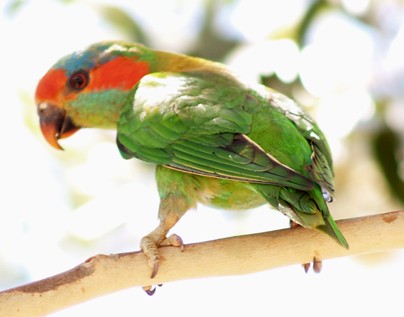Musk Lorikeet
A species of Small Australian Lorikeets Scientific name : Glossopsitta concinna Genus : Small Australian Lorikeets
Musk Lorikeet, A species of Small Australian Lorikeets
Botanical name: Glossopsitta concinna
Genus: Small Australian Lorikeets
Content
Description People often ask General Info
Description
The musk lorikeet is 22 centimetres (8.7 in) long. It is mainly green and it is identified by its red forehead, blue crown and a distinctive yellow band on its wing. Both upper and lower mandibles of the beak are red at the tip and darker near its base. 
Size
22 cm
Colors
Green
Yellow
Red
Blue
Life Expectancy
11 years
Nest Placement
Cavity
Feeding Habits
Musk Lorikeet primarily feeds on nectar, blossoms, and fruits such as apricots and apples. It forages in treetops, exhibiting a preference for bottlebrush and Grevillea species, utilizing a specialized brush-tipped tongue to extract nectar.
Habitat
Musk Lorikeet are primarily found in woodland and drier forest habitats, particularly those dominated by eucalyptus species. They show a preference for open habitats, including riparian zones along watercourses and groves within farmland. Their adaptability also brings them into suburban parks and gardens where they exploit fruit-bearing trees. Geographically, musk Lorikeet roam across broad woodlands and forests in southeastern mainland regions and Tasmania, often as nomadic visitors.
Dite type
Frugivorous
People often ask
General Info
Feeding Habits
Bird food type

Fruit
Distribution Area
Musk lorikeets are found in eastern New South Wales, Victoria, South Australia and Tasmania. They are an uncommon nomad in woodlands and drier forests in south-east mainland, mainly west of Great Dividing Range, and in Tasmania. Musk lorikeets have been sighted and are recent common visitors to fruit trees in the Punchbowl Area, near Launceston, Northern Tasmania. Favourite foods seem to include apricots, apples, bottlebrush flowers & nectar, as well as seeds and nectar from Grevillea spp. 
Species Status
Not globally threatened.
